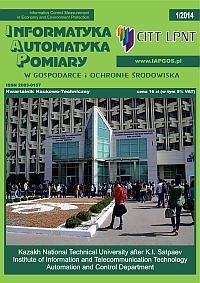ANALIZA NUMERYCZNA ZABIEGU SZTUCZNEJ HIPERTERMII
##plugins.themes.bootstrap3.article.sidebar##
Open full text
Numer Tom 4 Nr 1 (2014)
-
TECHNOLOGIA OPC JAKO NARZĘDZIE INTEGRACJI SYSTEMÓW ZAUTOMATYZOWANYCH
Aibek Ashatovich Karatayev, Vasiliy Pavlovich Palshin, Zauresh Mukashevna Yarmuhamedova7-10
-
EWOLUCJA MODELU SYMULACYJNEGO SYSTEMU SAMOREGULACJI NAPRĘŻENIA TAŚMY W TRYBIE DYNAMICZNYM W LINII CIĄGŁEGO CYNKOWANIA NA GORĄCO
Olessya A. Yuchshenko, Waldemar Wójcik11-13
-
SYSTEM AUTOMATYCZNEGO ZARZĄDZANIA ZESPOŁEM SAMOCHODÓW Z SILNIKAMI DIESLA NA PRZYKŁADZIE TRANSPORTU SAMOCHODOWEGO W KAMIENIOŁOMACH
Waldemar Wójcik, Batyrbek Suleimenov, Gennadiy Shadrin, Mikhail Shadrin, Dmitriy Porubov14-17
-
DEFINICJA OBIEKTÓW WIELOWYMIAROWEGO STEROWANIA PROCESAMI TECHNOLOGICZNYMI W HUTNICTWIE NA PODSTAWIE MODELU OPTYMALIZACJI
Shamil Koshymbaevich Koshymbaev, Zhibek Shegebaeva, Waldemar Wójcik18-20
-
SYNTEZA TRAJEKTORII PROGRAMOWYCH ROBOTA MANIPULACYJNEGO PRZY OGRANICZENIACH W POSTACI PRZESZKÓD
Muhit Baybatshaev, Akambay Beysembaev21-23
-
OPRACOWANIE OPTYMALNEGO STEROWANIA Z OGRANICZENIAMI Z WYKORZYSTANIEM METODY KOLEJNYCH APROKSYMACJI
Marat Orynbet, Gulmira Bayandina, Gula Tolebayeva24-26
-
KONCEPCJA BUDOWY INTELIGENTNEGO SYSTEMU KONTROLI I DIAGNOSTYKI OPERACYJNEJ STANU TECHNICZNEGO WYPOSAŻENIA
Batyrbek Suleimenov, Laura Sugurova, Nurbol Turynbetov, Alibek Suleimenov27-32
-
AUTOMATYCZNY RELAKSOMETR NMR DO KONTROLI PRODUKCJI I JAKOŚCI
Bekmurza Aitchanov, Anatoli Voronin, Janusz Partyka, Aitkul Aldibekova33-35
-
SYSTEM ZARZĄDZANIA JAKOŚCIĄ W DOSTARCZANIU CIEPŁA
Nigina Toktasynova, Gulmira Bazil, Shinar Adilova36-38
-
OKREŚLENIE STRUKTURY ZADAŃ STEROWANIA PIECEM DO WYTAPIANIA RUD FOSFORU
Akhmet Ibraev, Perdesh Khairullina39-40
-
METODY TWORZENIA OPTYMALNEGO SYSTEMU KONTROLI GRUPĄ BEZZAŁOGOWYCH STATKÓW POWIETRZNYCH
Maksym Korobchynskyi, Oleg Mashkov41-43
-
ANALIZA MODELU UŁAMKOWEGO RZĘDU PROCESÓW SZYBKICH REAKTORA JĄDROWEGO
Tomasz Karol Nowak, Kazimierz Duzinkiewicz44-47
-
ANALIZA NUMERYCZNA ZABIEGU SZTUCZNEJ HIPERTERMII
Łukasz Turchan, Ewa Majchrzak48-53
-
ANALIZA ZAKŁÓCEŃ W SIECIACH ELEKTROENERGETYCZNYCH WYWOŁANYCH WYŁADOWANIAMI PIORUNOWYMI
Mariusz Benesz, Rafał Tarko54-57
-
PROTOKÓŁ IPv6 - CHARAKTERYSTYKA I PROPONOWANE METODY WDROŻENIA W ISTNIEJĄCYCH SIECIACH IPv4 KORZYSTAJĄCYCH Z ROUTERÓW CISCO
Piotr Kowalik58-61
-
PORÓWNANIE DZIAŁANIA ALGORYTMÓW SYNCHRONIZACJI DLA ENERGOELEKTRONICZNYCH PRZEKSZTAŁTNIKÓW PODŁĄCZONYCH DO SIECI WEDŁUG ZAPROPONOWANYCH KRYTERIÓW OCENY
Piotr Lipnicki62-65
-
POMIAR WSPÓŁCZYNNIKA PRZEWODNOŚCI CIEPLNEJ WŁAŚCIWEJ CIECZY ELEKTROIZOLACYJNYCH Z WYKORZYSTANIEM AUTORSKIEGO UKŁADU POMIAROWEGO
Grzegorz Dombek66-68
-
MODELOWANIE PRZEPŁYWU CIEPŁA W DWUWYMIAROWYM CIELE KRYSTALICZNYM ZA POMOCĄ INTERWAŁOWEJ METODY SIATEK BOLTZMANNA
Alicja Piasecka-Belkhayat, Anna Korczak69-71
-
PROTOTYP UKŁADU SCALONEGO Z DWUSTOPNIOWYM PRZETWARZANIEM IMPULSU DLA POTRZEB NISKOMOCOWEGO POMIARU CZASU WYSTĄPIENIA ZDARZENIA I AMPLITUDY ŁADUNKU WEJŚCIOWEGO
Krzysztof Kasiński, Rafał Kłeczek72-75
Archiwum
-
Tom 8 Nr 4
2018-12-16 16
-
Tom 8 Nr 3
2018-09-25 16
-
Tom 8 Nr 2
2018-05-30 18
-
Tom 8 Nr 1
2018-02-28 18
-
Tom 6 Nr 4
2016-12-22 16
-
Tom 6 Nr 3
2016-08-08 18
-
Tom 6 Nr 2
2016-05-10 16
-
Tom 6 Nr 1
2016-02-04 16
-
Tom 5 Nr 4
2015-10-28 19
-
Tom 5 Nr 3
2015-09-02 17
-
Tom 5 Nr 2
2015-06-30 15
-
Tom 5 Nr 1
2015-03-31 18
-
Tom 4 Nr 4
2014-12-09 29
-
Tom 4 Nr 3
2014-09-26 22
-
Tom 4 Nr 2
2014-06-18 21
-
Tom 4 Nr 1
2014-03-12 19
-
Tom 3 Nr 4
2013-12-27 20
-
Tom 3 Nr 3
2013-07-24 13
-
Tom 3 Nr 2
2013-05-16 9
-
Tom 3 Nr 1
2013-02-14 11
##plugins.themes.bootstrap3.article.main##
DOI
Authors
Abstrakt
Artykuł dotyczy numerycznego modelowania zabiegu sztucznej hipertermii. Analiza skuteczności zabiegu jest rozpatrywana nie tylko na podstawie czasoprzestrzennych rozkładów temperatury, ale także w oparciu o parametr dawki termicznej. Do modelowania przepływu ciepła w rozpatrywanym obszarze wykorzystano uogólnione równanie z dwoma czasami opóźnień. Na potrzeby obliczeń numerycznych napisano autorski program oparty o obliczenia równoległe.
Słowa kluczowe:
Bibliografia
Afrin N., Zhang Y., Chen J.K.: Thermal lagging in living biological tissue based on nonequilibrium heat transfer between tissue, arterial and venous bloods, International Journal of Heat and Mass Transfer, 2011, 54, pp. 2419–2426.
Cattaneo C.: A form of heat conduction equation which eliminates the paradox of instantaneous propagation, Comp. Rend., 1958, 247, pp. 431-433.
Ciesielski M.: Mochnacki B., Numerical analysis of interactions between skin surface temperature and burn wound shape, Scientific Research of Institute of Mathematics and Computer Science, 2012, 1(11), pp. 15-22.
Khaled A.R.A., Vafai K.: The role of porous media in modeling flow and heat transfer in biological tissues, International Journal of Heat and Mass Transfer, 2003, 46, pp. 4989–5003.
Kirk D.B., Wen-mei W. Hwu: Programming Massively Parallel Processors, Second Edition: A Hands-on Approach, Morgan Kaufmann, 2012.
Majchrzak E.: Numerical modelling of bio-heat transfer using the boundary element method, Journal of Theoretical and Applied Mechanics, 1998, 2(36), pp. 437-455.
Majchrzak E.: Mochnacki B.: Numerical methods. Theoretical bases, practical aspects and algorithms, Publ. of the Silesian University of Technology, Gliwice, Poland, 2004.
Majchrzak E., Poteralska J.: Turchan Ł,: Comparison of different bioheat transfer models used in numerical modelling of a hyperthermia therapy, International Conference of the Polish Society of Biomechanics “Biomechanics 2010”, Book of Abstracts, Warsaw, Poland, 2010, pp. 137-138.
Majchrzak E., Turchan L.: Numerical modeling of a hyperthermia therapy using dual-phase-lag model of bioheat transfer, 19th International Conference on Computer Methods in Mechanics CMM 2011, Short Papers, Warsaw, Poland, 2011, pp. 337-338.
Minkowycz, W.J., Haji-Sheikh, A., Vafai, K.: On departure from local thermal equilibrium in porous media due to a rapidly changing heat source: the Sparrow number, Int. J. Heat Mass Transfer, 42, 1999, pp. 3373-3385.
Nakayama A., Kuwahara F.: A general bioheat transfer model based on the theory of porous media, International Journal of Heat and Mass Transfer, 51, 2008, pp. 3190–3199.
Peng T., O’Neill D.P., Payne S.J.: A two-equation coupled system for determination of liver tissue temperature during thermal ablation, International Journal of Heat and Mass Transfer, 54, 2011, pp. 2100-2109.
Wen-mei W. Hwu: GPU Computing Gems Emerald Edition, Morgan Kaufmann, 2011.
Yuan, P.: Numerical analysis of temperature and thermal dose response of biological tissues to thermal non-equilibrium during hyperthermia therapy– Medical Engineering & Physics, 2008, 20, pp. 135-143.
##plugins.themes.bootstrap3.article.details##
Abstract views: 228
Licencja

Utwór dostępny jest na licencji Creative Commons Uznanie autorstwa – Na tych samych warunkach 4.0 Miedzynarodowe.






